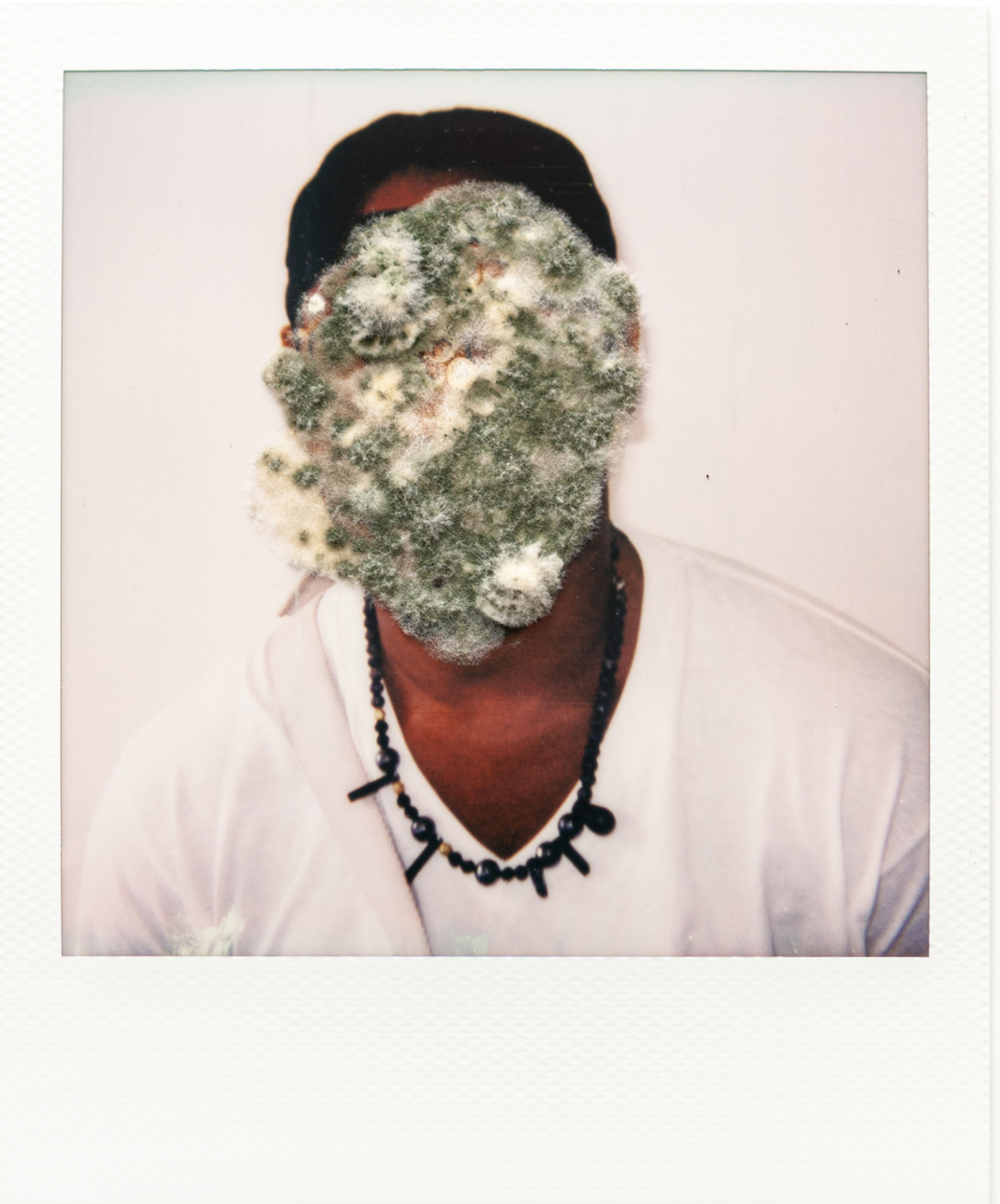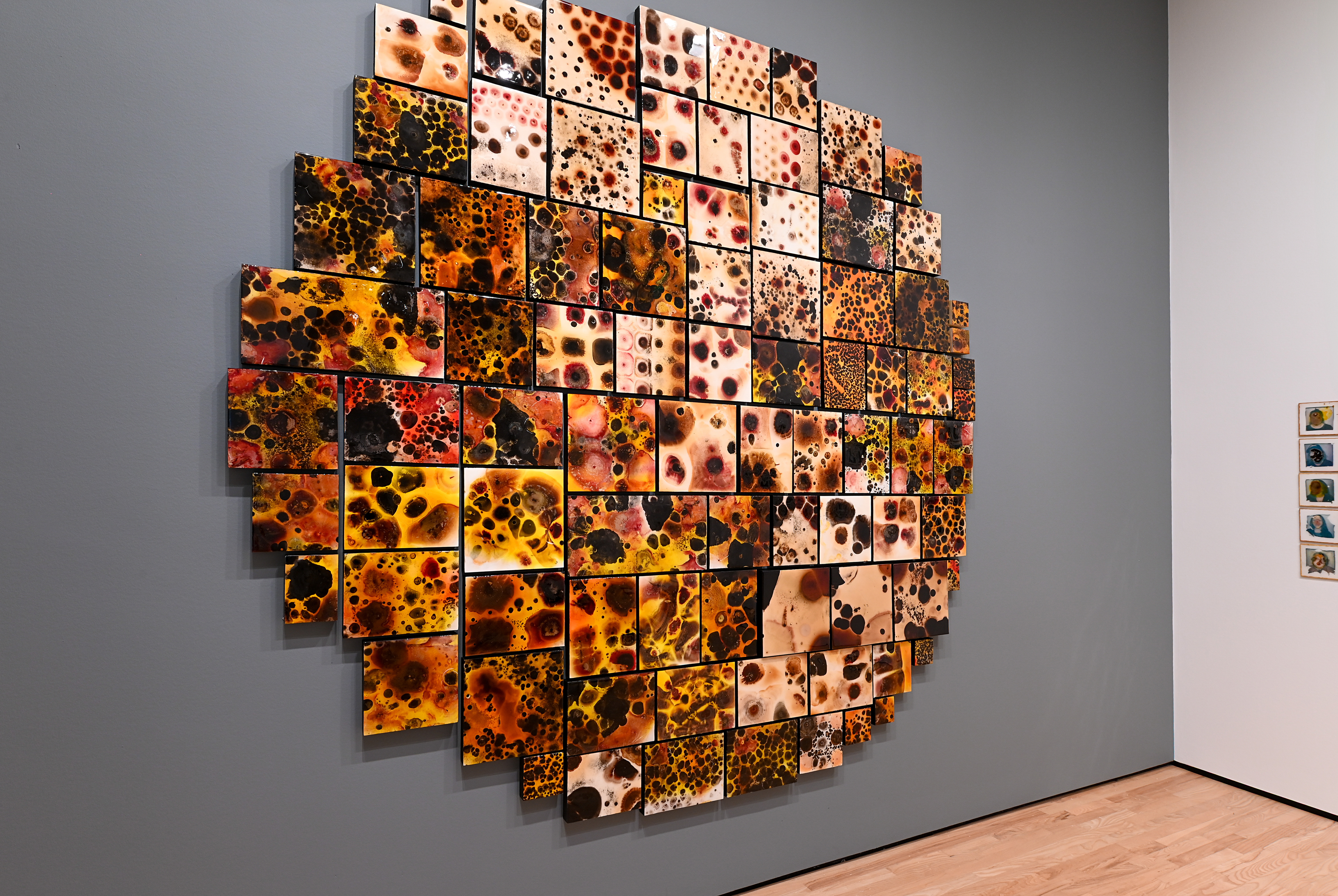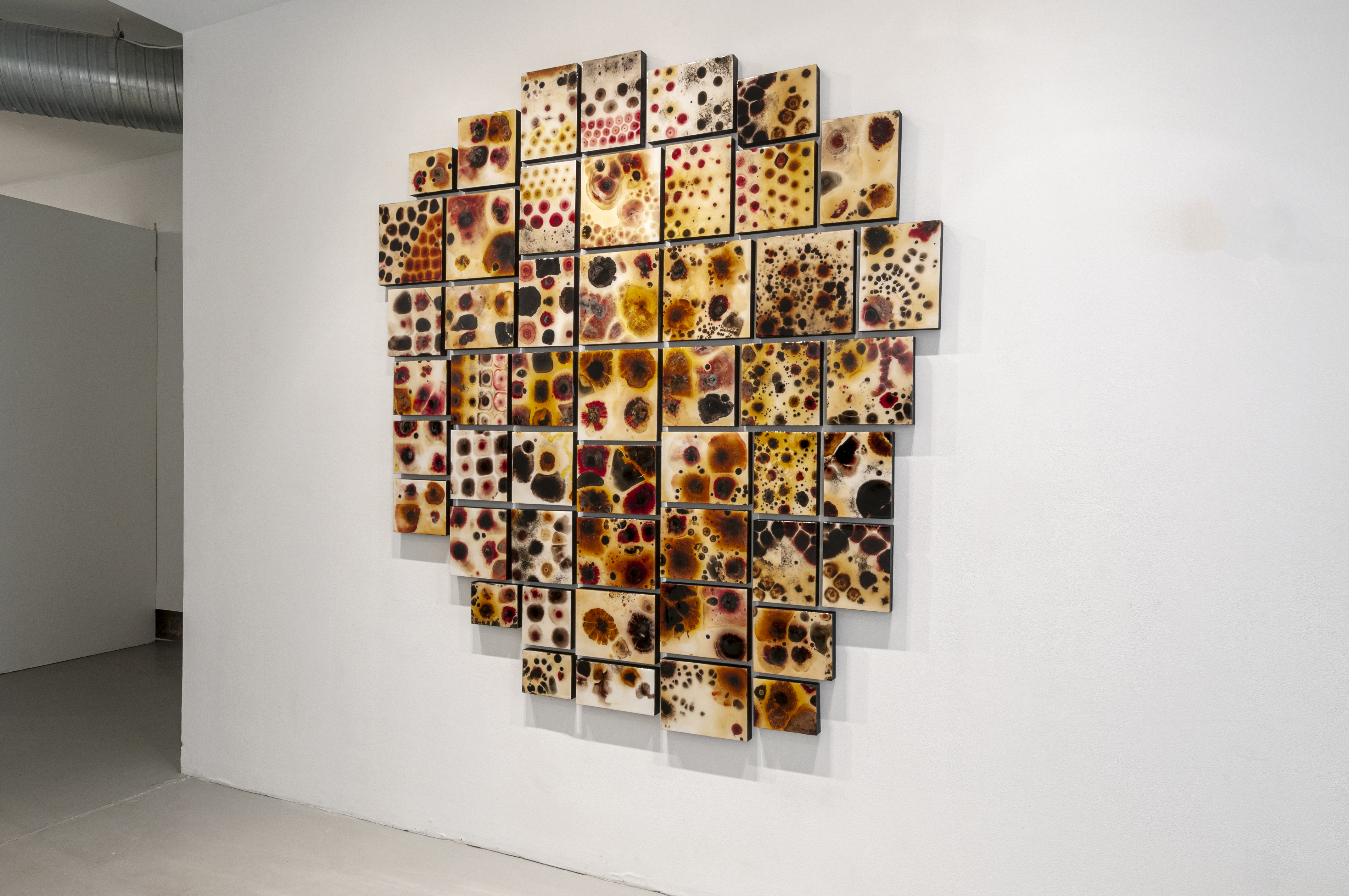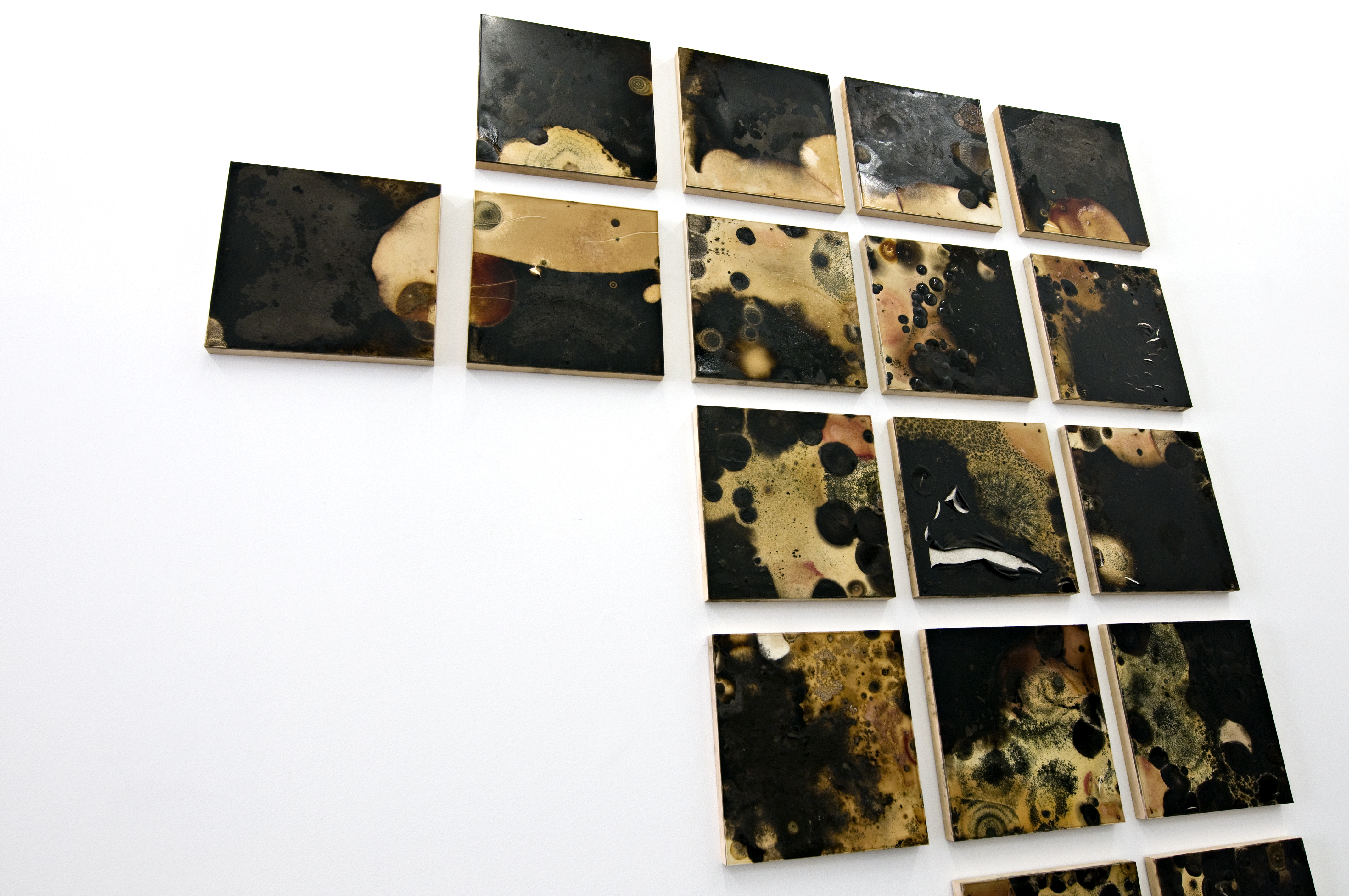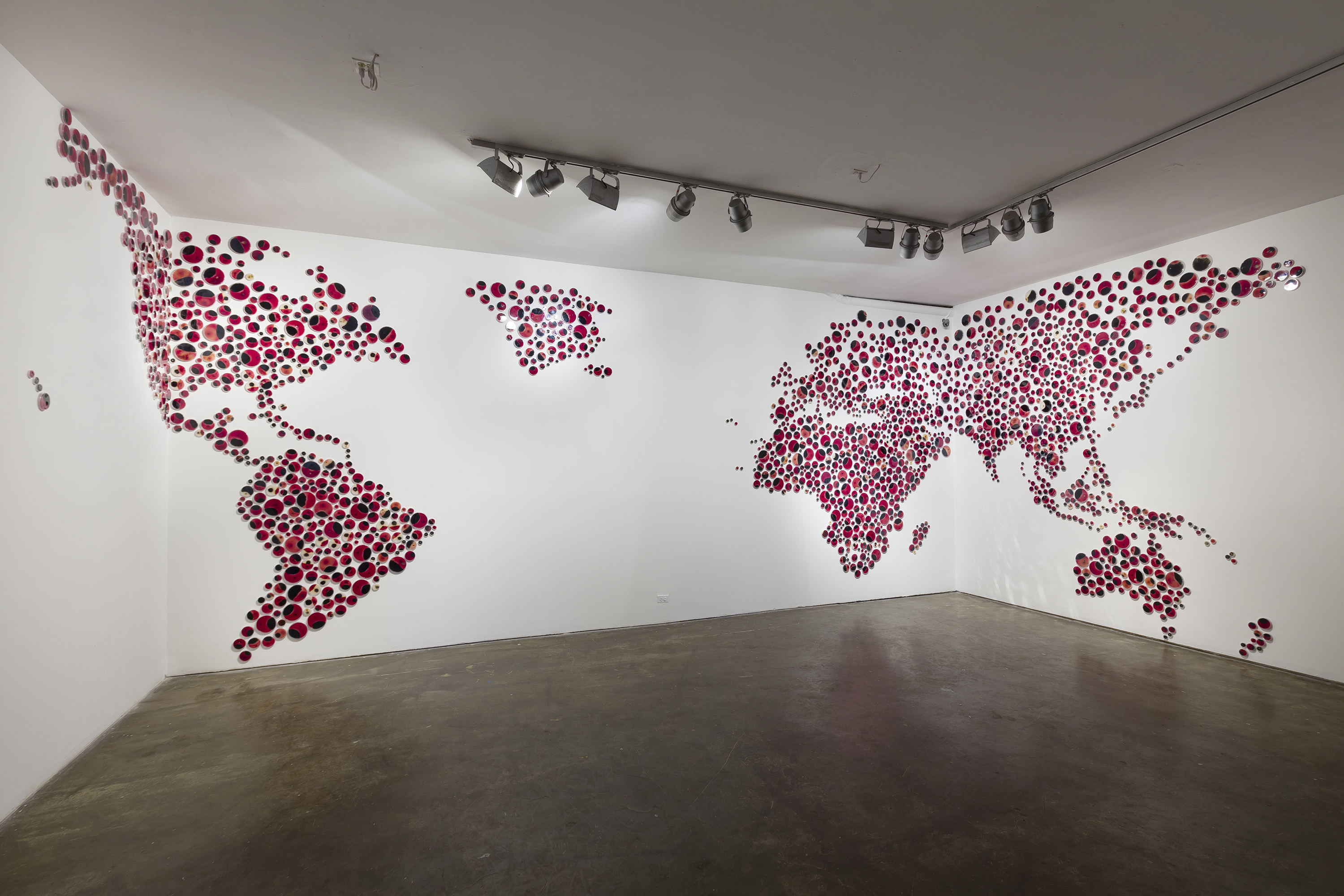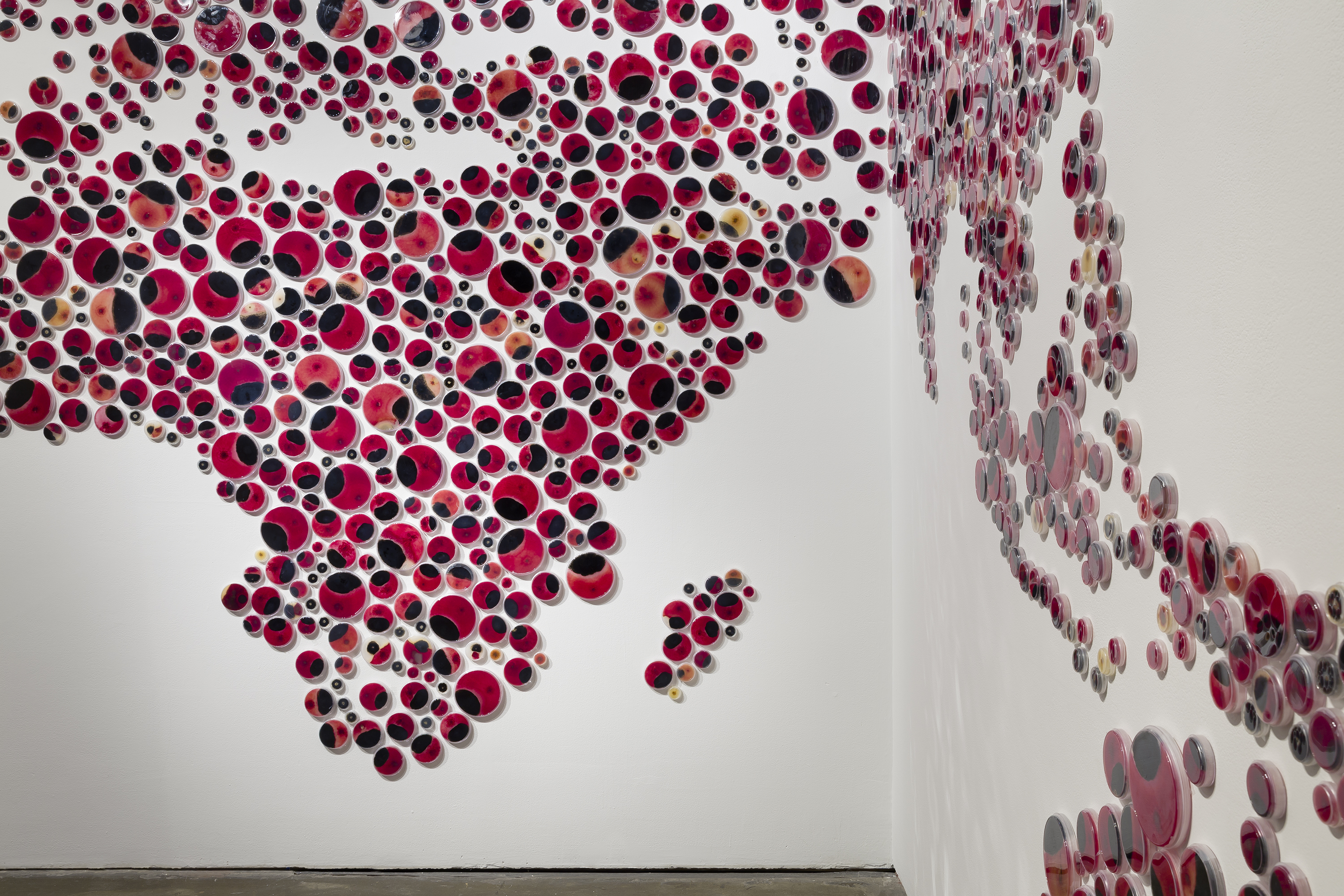Share:
About Selin
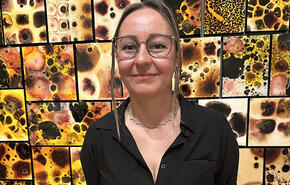
Selin Balci is an interdisciplinary artist and researcher who merges art and science through innovative use of biological materials, scientific tools, and traditional art supplies. Her work is categorized as bio-art, a contemporary artistic approach that incorporates living organisms into creative expression. With a background in both science and art, Selin adeptly explores the dynamic relationship between the natural world and human intervention within this emerging field. Selin holds a Master of Fine Arts from the University of Maryland, a Bachelor of Fine Arts from West Virginia… more
30 Faces
'30 Faces', 2024, Mold spores and growth Polaroid image transfer, mounted on boards, 6x6" each
In '30 Faces,' participants actively engage with the artwork through the contribution of their unseen microorganisms. After capturing their Polaroid portraits and collecting microbial samples from their bodies and living environments, I reconstruct their images using the microorganisms they coexist with. Each participant’s unique microbiome transforms their photograph into an evolving new reality. As these microorganisms become visible through distinct colors and organic forms, the interactions among these unseen inhabitants shape a new identity for the participants, revealing an intricate, symbiotic relationship between humans and the microscopic world surrounding them.
-
 Fertile Faces Installation ViewFertile Faces, 2022, Mold spores on Polaroid covered with epoxy, 4.233 x 3.483 inches at Mass MoCA Artist studios
Fertile Faces Installation ViewFertile Faces, 2022, Mold spores on Polaroid covered with epoxy, 4.233 x 3.483 inches at Mass MoCA Artist studios -
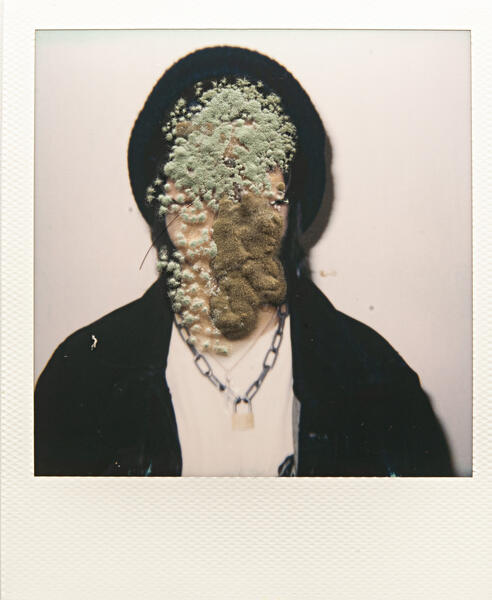 Fertile Faces (Jo Cosme)Fertile Faces (Jo Cosme), 2022, Mold spores on Polaroid covered with epoxy, 4.233 x 3.483 inches In ‘Fertile Soils’, the resident artists at Mass MoCA and Istanbul Art Residency interacted and contributed to my work with their unseen microorganisms. After taking their polaroid portraits and collecting samples from their body, I reconstructed their images with their mold spores. Each person’s unique microbiome transformed their portraits into a new reality. While making the hosts’ microorganisms visible to our eyes with distinct colors and forms, the unseen inhabitants’ interactions and their natural form created a new identity of the artists.
Fertile Faces (Jo Cosme)Fertile Faces (Jo Cosme), 2022, Mold spores on Polaroid covered with epoxy, 4.233 x 3.483 inches In ‘Fertile Soils’, the resident artists at Mass MoCA and Istanbul Art Residency interacted and contributed to my work with their unseen microorganisms. After taking their polaroid portraits and collecting samples from their body, I reconstructed their images with their mold spores. Each person’s unique microbiome transformed their portraits into a new reality. While making the hosts’ microorganisms visible to our eyes with distinct colors and forms, the unseen inhabitants’ interactions and their natural form created a new identity of the artists. -
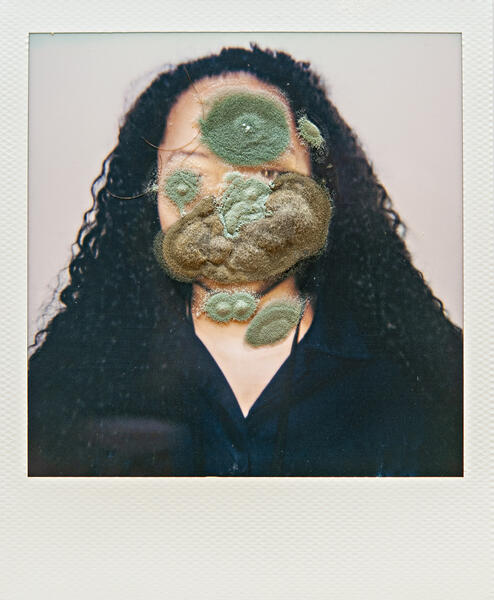 Fertile Faces (Tatiana)Fertile Faces (Tatiana), 2022, Mold spores on Polaroid, 3.108 × 3.024 inches
Fertile Faces (Tatiana)Fertile Faces (Tatiana), 2022, Mold spores on Polaroid, 3.108 × 3.024 inches -
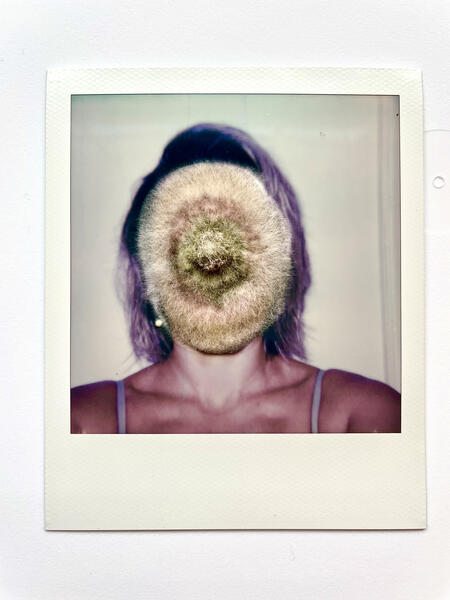 Fertile Faces (Self-Portrait)Fertile Faces, 2021, Mold spores on Polaroid covered with epoxy, 4.233 x 3.483 inches
Fertile Faces (Self-Portrait)Fertile Faces, 2021, Mold spores on Polaroid covered with epoxy, 4.233 x 3.483 inches -
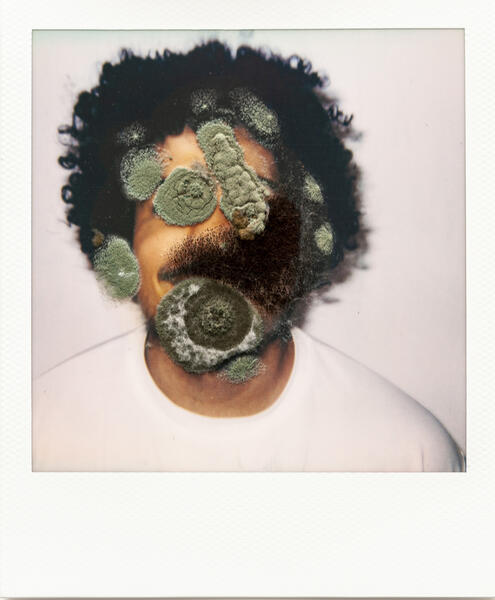 Fertile Faces (Oscar)Fertile Faces (Oscar), 2022, Mold spores on Polaroid covered with epoxy, 4.233 x 3.483 inches
Fertile Faces (Oscar)Fertile Faces (Oscar), 2022, Mold spores on Polaroid covered with epoxy, 4.233 x 3.483 inches -
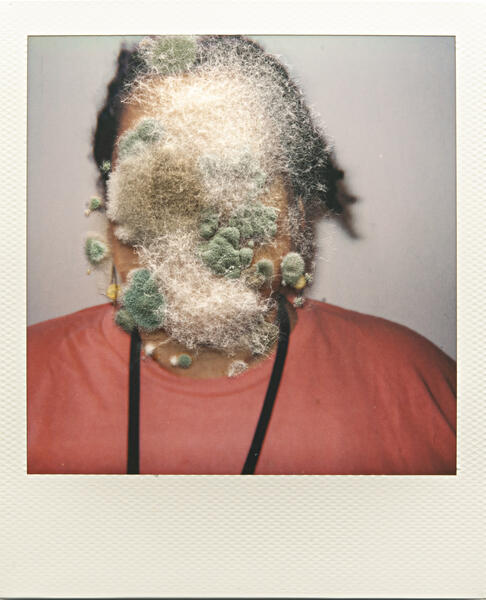 Fertile Faces (Gisela Rosario Ramos)Fertile Faces (Gisela Rosario Ramos), 2022, Mold spores on Polaroid covered with epoxy, 4.233 x 3.483 inches
Fertile Faces (Gisela Rosario Ramos)Fertile Faces (Gisela Rosario Ramos), 2022, Mold spores on Polaroid covered with epoxy, 4.233 x 3.483 inches -
 Fertile Faces (Becky)Fertile Faces (Becky), 2022, Mold spores on Polaroid covered with epoxy, 4.233 x 3.483 inches
Fertile Faces (Becky)Fertile Faces (Becky), 2022, Mold spores on Polaroid covered with epoxy, 4.233 x 3.483 inches -
 Fertile Faces (Carolina)Fertile Faces (Carolina), 2022, Mold spores on Polaroid covered with epoxy, 4.233 x 3.483 inches
Fertile Faces (Carolina)Fertile Faces (Carolina), 2022, Mold spores on Polaroid covered with epoxy, 4.233 x 3.483 inches -
 Fertile Faces (Freddie)Fertile Faces (Freddie), 2022, Mold spores on Polaroid covered with epoxy, 4.233 x 3.483 inches
Fertile Faces (Freddie)Fertile Faces (Freddie), 2022, Mold spores on Polaroid covered with epoxy, 4.233 x 3.483 inches -
Fertile Faces (Self-portrait), Video, 32 sec
Contamination Series, 2019-2025
Contamination Series
Ongoing work since 2011
Contamination Series uses the mold spores collected from my surroundings to make the invisible microbiome visible while documenting, preserving, and creating a historical record of microbial life existing around me. I create large-scale installations formed by microorganisms on different-sized panels. These panels later assemble to construct an abstract landscape.
I isolate these organisms from soil, plants, and trees. I incubate them in a synthetic but habitable environment where I witness living organisms' interactions, struggles, and conflicts across the picture surface. When germinating, mold spores physically inscribe their colors and form on the surface of a panel, which is the living platform. Once the work is completed, microorganisms shift from the micro-world to the macro-world and have a physical appearance. They serve as a painting agent where I make the invisible landscape, visible.
-
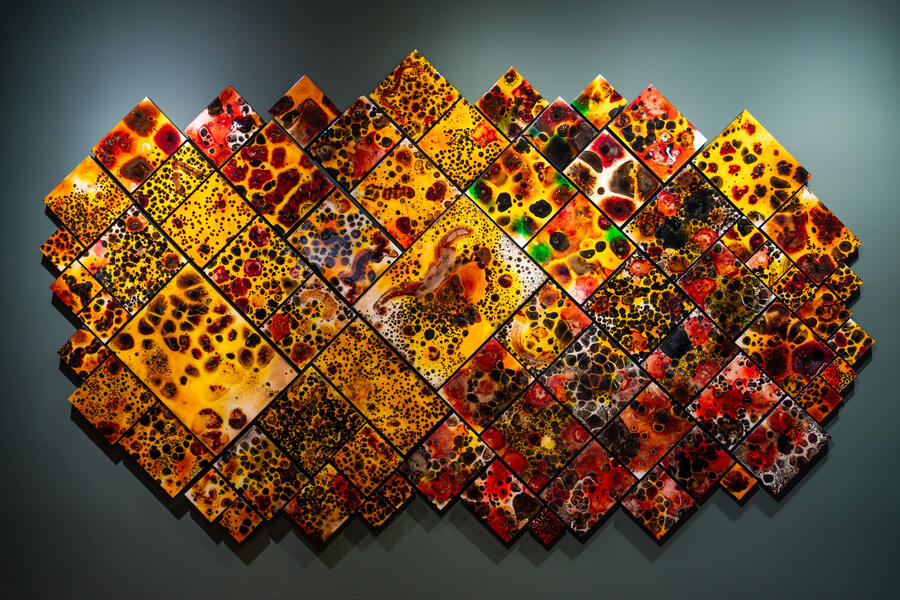 Contamination '66'
Contamination '66'2025
Mold Spores on boards covered with epoxy resin
8x10'
At Staten Island Museum, NY -
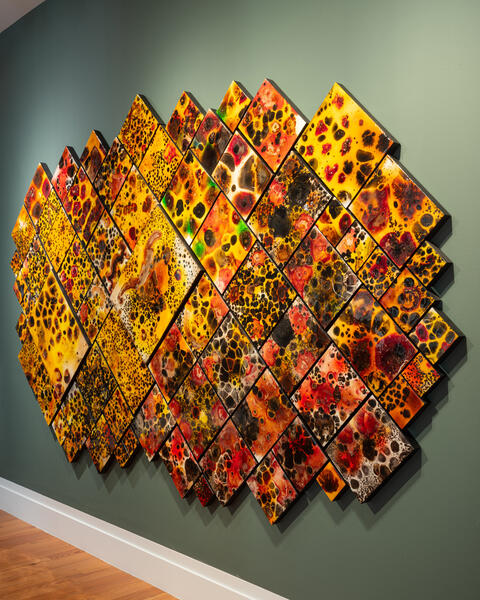 Contamination '66'
Contamination '66'Contamination '66'
2025
Mold Spores on boards covered with epoxy resin
8x10'
At Staten Island Museum, NY -
 Contamination '66'
Contamination '66'2025
Mold Spores on boards covered with epoxy resin
8x10'
At Staten Island Museum, NY -
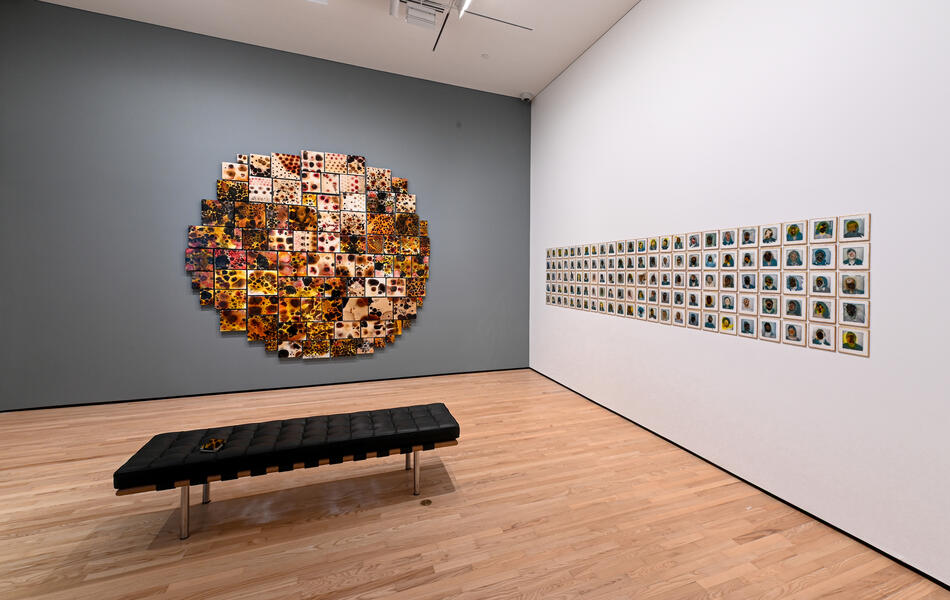 Contamination '66'
Contamination '66'2025
Mold spores on boards covered with resin
10x10'
At the Baltimore Museum of Art
Created with mold spores taken from Wyman Park, Baltimore, MD -
 Contamination (39° 19.718′ N, 76° 37.326′ W)
Contamination (39° 19.718′ N, 76° 37.326′ W)2025
Mold spores on boards covered with resin
10x10'
At the Baltimore Museum of Art
Created with mold spores taken from Wyman Park, Baltimore, MD -
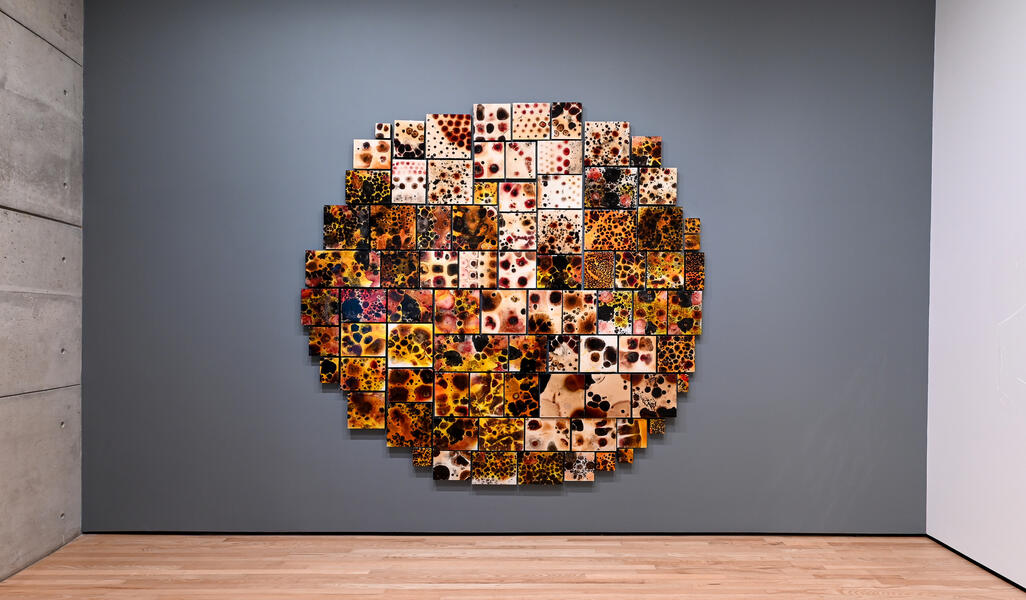 Contamination (39° 19.718′ N, 76° 37.326′ W)
Contamination (39° 19.718′ N, 76° 37.326′ W)Contamination (39° 19.718′ N, 76° 37.326′ W)
2025
Mold spores on boards covered with resin
10x10'
At the Baltimore Museum of Art
Created with mold spores taken from Wyman Park, Baltimore, MD -
 Colony '50'Colony '50', 2021, Mold spores on panels covered with resin, 8x9ft At Hamiltonian Gallery, Washington DC I use live microscopic mold that leaves physical inscriptions by direct contact on the surface of a paper or board, which creates a living platform. In Contamination Series, the surface of each panel is laced with graceful, brilliant mold until the entire surface is covered and patterned with circular borders
Colony '50'Colony '50', 2021, Mold spores on panels covered with resin, 8x9ft At Hamiltonian Gallery, Washington DC I use live microscopic mold that leaves physical inscriptions by direct contact on the surface of a paper or board, which creates a living platform. In Contamination Series, the surface of each panel is laced with graceful, brilliant mold until the entire surface is covered and patterned with circular borders -
 Colony '50'Colony '50', 2021, Mold spores on panels covered with resin, 8x9ft At Hamiltonian Gallery, Washington DC
Colony '50'Colony '50', 2021, Mold spores on panels covered with resin, 8x9ft At Hamiltonian Gallery, Washington DC -
My Process
Contamination Series, 2013-2018
-
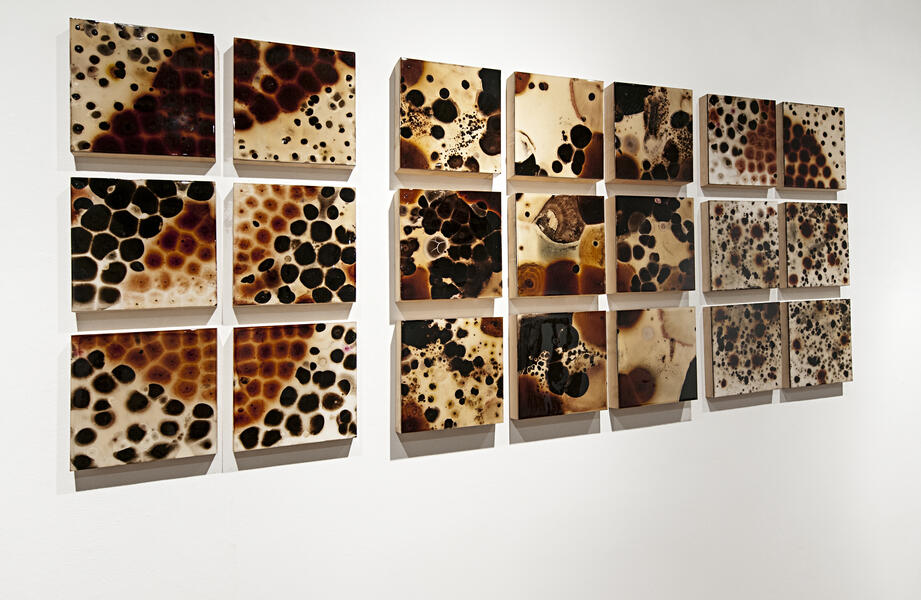 Annapolis (Highland Beach)Microscopic mold on panels, 40x100”, 2018 at School 33 Gallery, Baltimore, Maryland. In this work, I used microscopic mold that is collected from Highland Beach, Annapolis to create an unseen landscape of the scene. Emerging from a diverse array of mold, this work interprets the landscape with invisible inhabitants.
Annapolis (Highland Beach)Microscopic mold on panels, 40x100”, 2018 at School 33 Gallery, Baltimore, Maryland. In this work, I used microscopic mold that is collected from Highland Beach, Annapolis to create an unseen landscape of the scene. Emerging from a diverse array of mold, this work interprets the landscape with invisible inhabitants. -
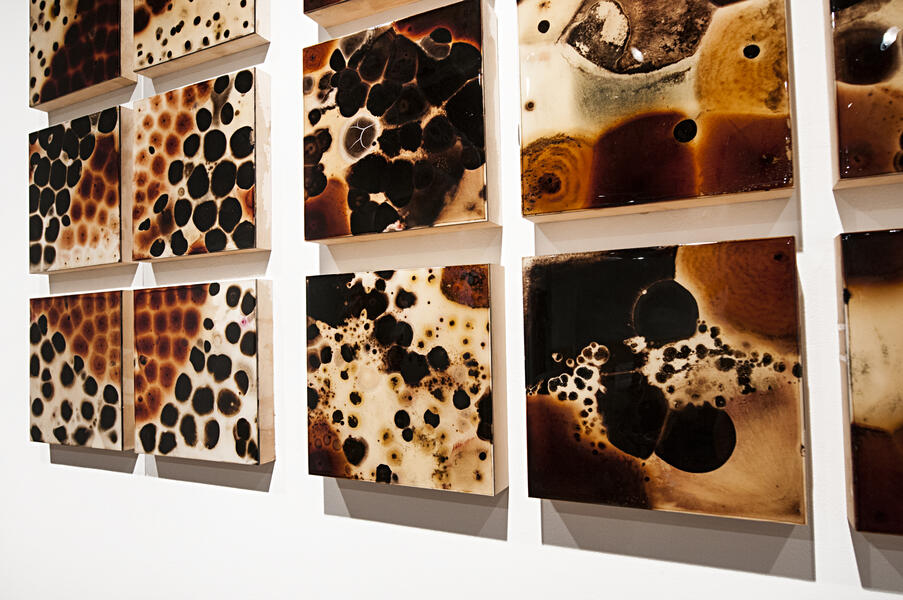 Annapolis (Highland Beach)Microscopic mold on panels, 40x100”, 2018
Annapolis (Highland Beach)Microscopic mold on panels, 40x100”, 2018 -
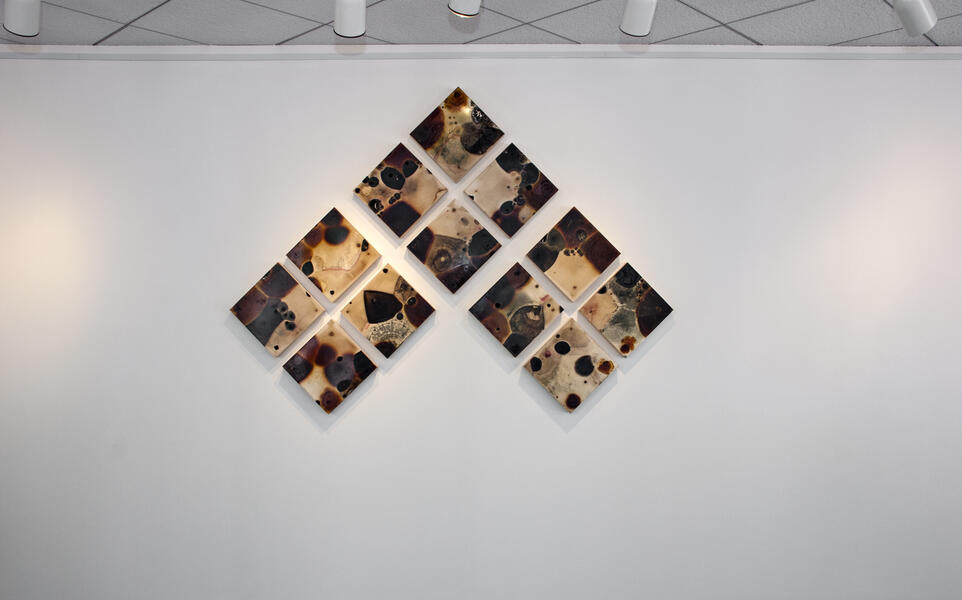 Contamination 28Contamination'28', mold on panels, 60x60", 2014 at Trawick Prize Exhibition, Gallery B, Bethesda, Maryland. DESCRIPTION: I use live microscopic mold that leaves physical inscriptions by direct contact on the surface of a paper or board, which creates a living platform. In Contamination Series, the surface of each panel is laced with graceful, brilliant mold until the entire surface is covered and patterned with circular borders. Then, I assembled these forms and shapes that mold produced, to create various visual references that can relate to both natural and human impacted landscapes. The forms have similarities to human-induced activities on the landscape. They create territories, boundaries, and borderlines and end up with conflicts on the picture surface. "Balci gives living microbes a place to grow and organize themselves on specially prepared plates. The microorganisms, which normally are invisible to the naked eye, are made visible in these conditions. They create maps of “territories” as they battle for the food sources, and their behavior is disturbingly parallel to many scenarios of human conflict. The artist organizes and assembles the landscapes or maps that result from these natural migrations into abstract compositions that are limited in tonal variation but elegant in form." by Claudia Rousseau, Gazette.net, September 18, 2013.
Contamination 28Contamination'28', mold on panels, 60x60", 2014 at Trawick Prize Exhibition, Gallery B, Bethesda, Maryland. DESCRIPTION: I use live microscopic mold that leaves physical inscriptions by direct contact on the surface of a paper or board, which creates a living platform. In Contamination Series, the surface of each panel is laced with graceful, brilliant mold until the entire surface is covered and patterned with circular borders. Then, I assembled these forms and shapes that mold produced, to create various visual references that can relate to both natural and human impacted landscapes. The forms have similarities to human-induced activities on the landscape. They create territories, boundaries, and borderlines and end up with conflicts on the picture surface. "Balci gives living microbes a place to grow and organize themselves on specially prepared plates. The microorganisms, which normally are invisible to the naked eye, are made visible in these conditions. They create maps of “territories” as they battle for the food sources, and their behavior is disturbingly parallel to many scenarios of human conflict. The artist organizes and assembles the landscapes or maps that result from these natural migrations into abstract compositions that are limited in tonal variation but elegant in form." by Claudia Rousseau, Gazette.net, September 18, 2013. -
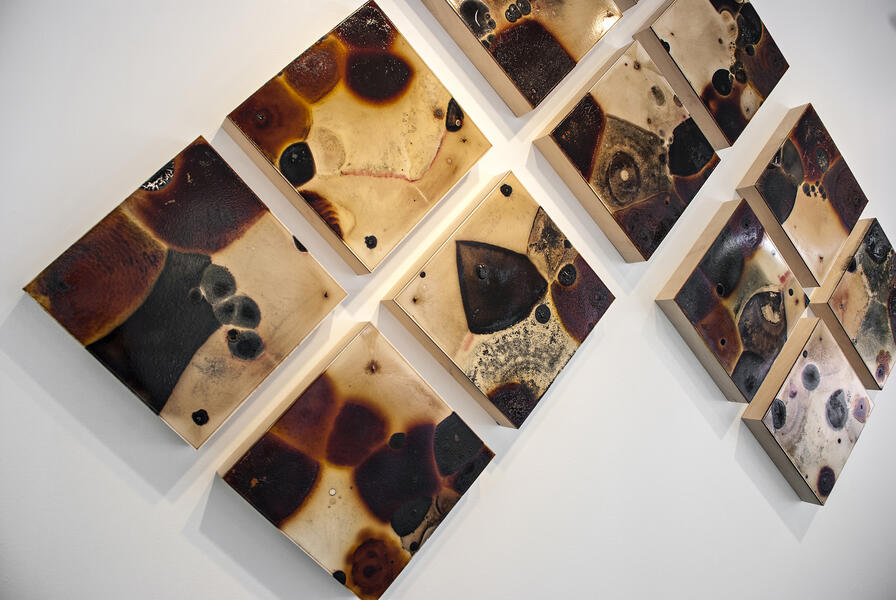 Contamination 28 (detail)Contamination'28', mold on panels, 60x60", 2014 at Trawick Prize Exhibition, Gallery B, Bethesda, Maryland.
Contamination 28 (detail)Contamination'28', mold on panels, 60x60", 2014 at Trawick Prize Exhibition, Gallery B, Bethesda, Maryland. -
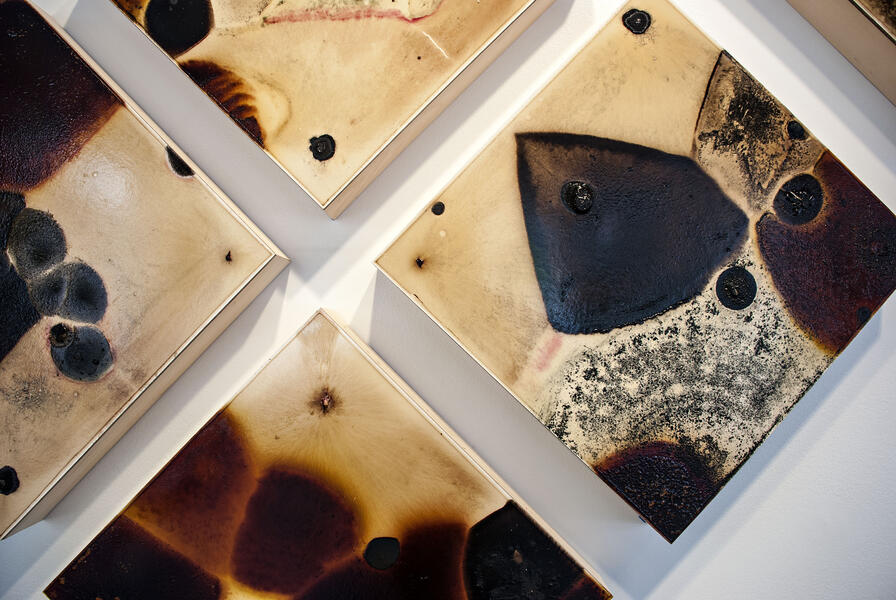 Contamination 28 (detail)Contamination'28', mold on panels, 60x60", 2014 at Trawick Prize Exhibition, Gallery B, Bethesda, Maryland.
Contamination 28 (detail)Contamination'28', mold on panels, 60x60", 2014 at Trawick Prize Exhibition, Gallery B, Bethesda, Maryland. -
 Contamination 32Contamination 32, mold on panels, 70x70", 2013 The University of Maryland, College Park Stamp Student Union, Contemporary Art Permanent Collection, College Park, MD.
Contamination 32Contamination 32, mold on panels, 70x70", 2013 The University of Maryland, College Park Stamp Student Union, Contemporary Art Permanent Collection, College Park, MD. -
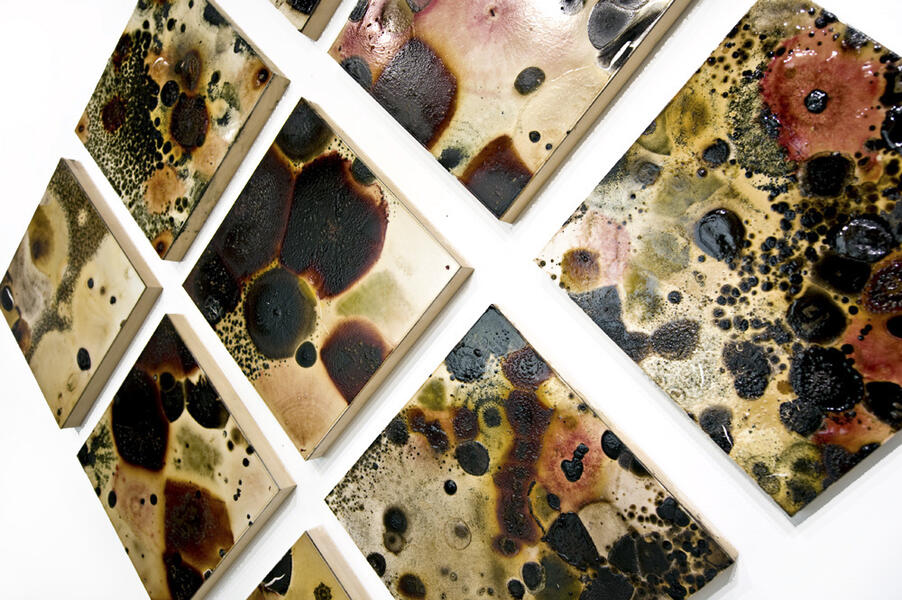 Contamination 32Contamination 32, mold on panels, 70x70", 2013 The University of Maryland, College Park Stamp Student Union, Contemporary Art Permanent Collection, College Park, MD.
Contamination 32Contamination 32, mold on panels, 70x70", 2013 The University of Maryland, College Park Stamp Student Union, Contemporary Art Permanent Collection, College Park, MD. -
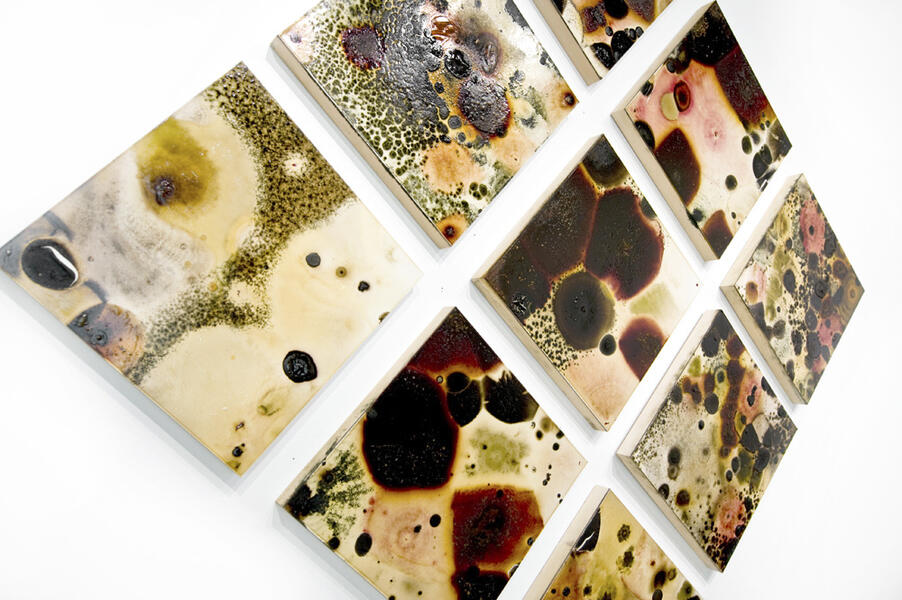 Contamination 32Contamination 32, mold on panels, 70x70", 2013 The University of Maryland, College Park Stamp Student Union, Contemporary Art Permanent Collection, College Park, MD.
Contamination 32Contamination 32, mold on panels, 70x70", 2013 The University of Maryland, College Park Stamp Student Union, Contemporary Art Permanent Collection, College Park, MD. -
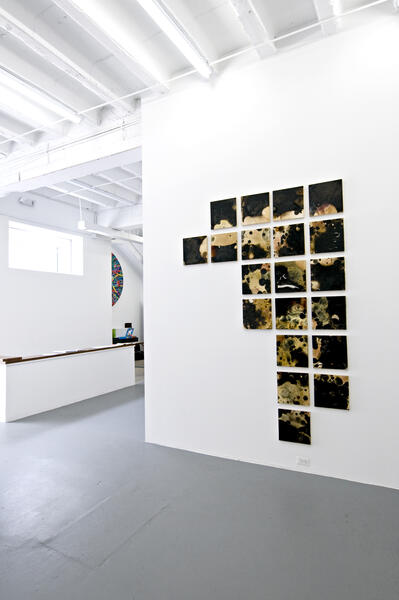 Contamination IIContamination II (detail), mold on panels, 60x110", 2012 at ConnerSmith Gallery, Washignton, DC
Contamination IIContamination II (detail), mold on panels, 60x110", 2012 at ConnerSmith Gallery, Washignton, DC -
 Contamination II (detail)Contamination II (detail), mold on panels, 60x110", 2012 at ConnerSmith Gallery, Washignton, DC
Contamination II (detail)Contamination II (detail), mold on panels, 60x110", 2012 at ConnerSmith Gallery, Washignton, DC
Contamination Series, 2011-2012
by CHRISTINA CAUTERUCCI SEPTEMBER 19TH, 2014
-
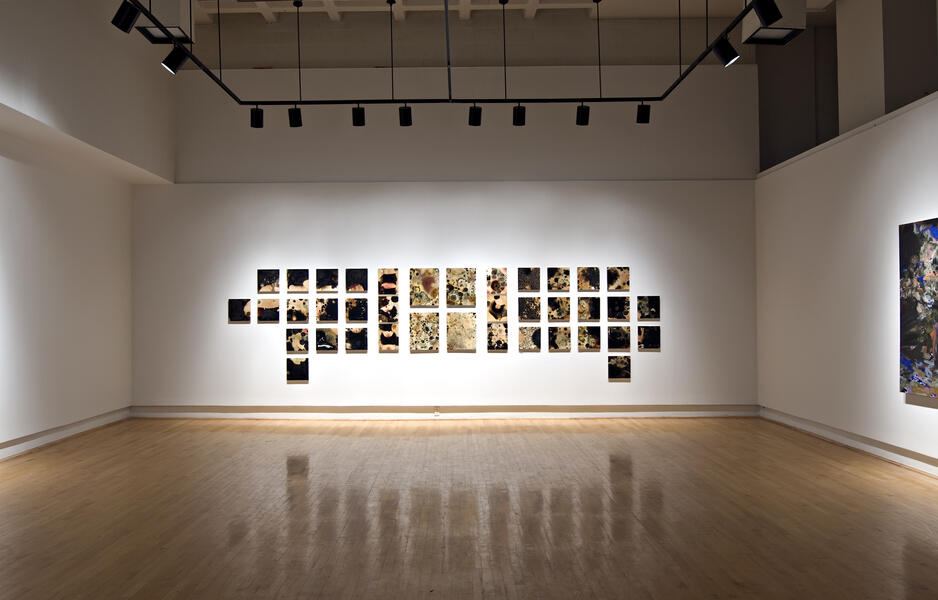 Contamination IContamination I, Mold on panels, 70x220", 2012 at University of Maryland Art Gallery, College Park, Maryland
Contamination IContamination I, Mold on panels, 70x220", 2012 at University of Maryland Art Gallery, College Park, Maryland -
 Contamination IContamination I, Mold on panels, 70x220", 2012 at University of Maryland Art Gallery, College Park, Maryland
Contamination IContamination I, Mold on panels, 70x220", 2012 at University of Maryland Art Gallery, College Park, Maryland -
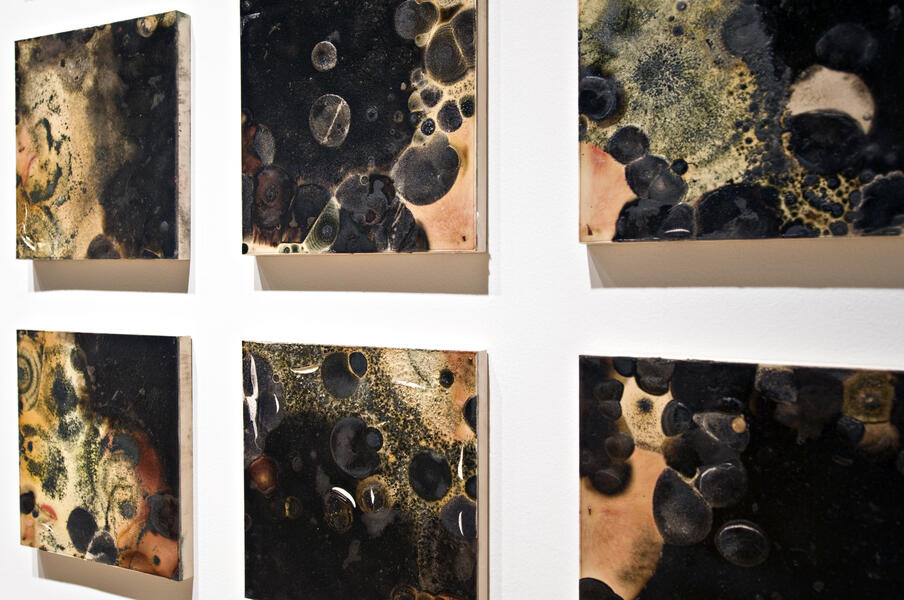 Contamination IContamination I, Mold on panels, 70x220", 2012 at University of Maryland Art Gallery, College Park, Maryland
Contamination IContamination I, Mold on panels, 70x220", 2012 at University of Maryland Art Gallery, College Park, Maryland -
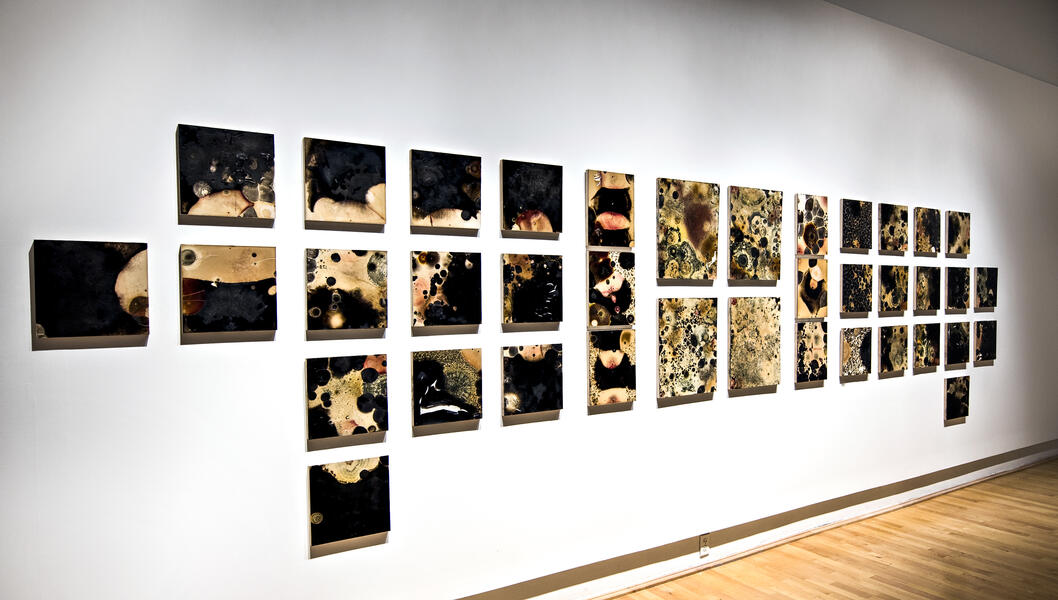 Contamination IContamination I, Mold on panels, 70x220", 2012 at University of Maryland Art Gallery, College Park, Maryland
Contamination IContamination I, Mold on panels, 70x220", 2012 at University of Maryland Art Gallery, College Park, Maryland -
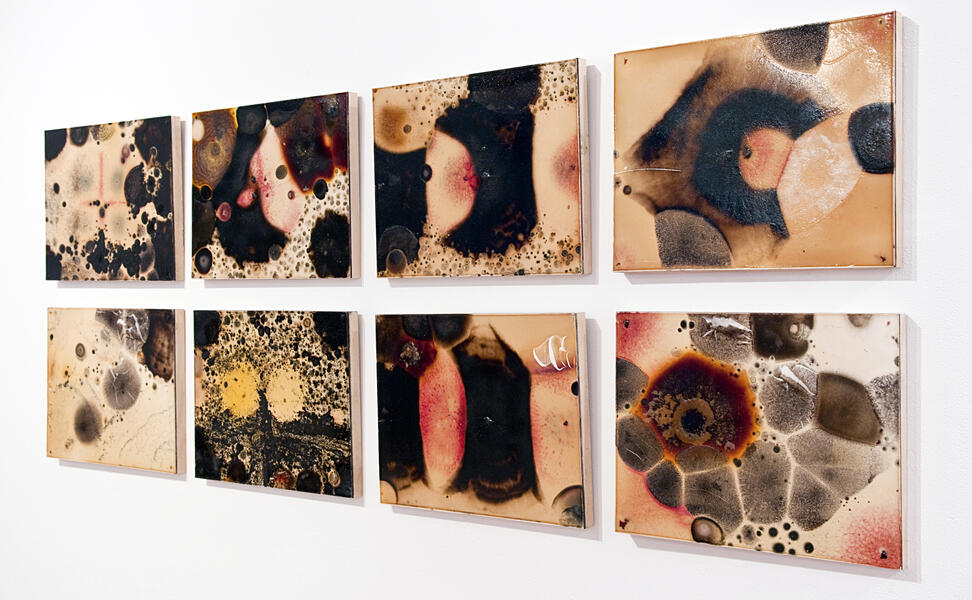 BoundBound, Mold on panels, each 11x14", 2011 at The Pearl Conard Art Gallery, The Ohio State University, Mansfield, Ohio
BoundBound, Mold on panels, each 11x14", 2011 at The Pearl Conard Art Gallery, The Ohio State University, Mansfield, Ohio -
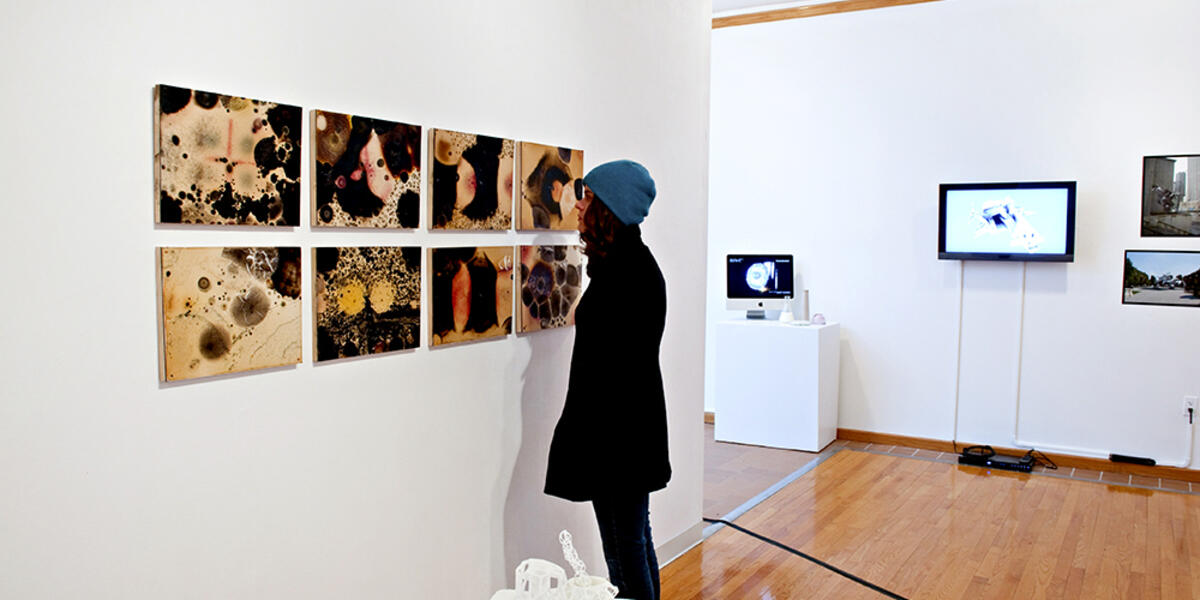 BoundBound, Mold on panels, each 11x14", 2011 at The Pearl Conard Art Gallery, The Ohio State University, Mansfield, Ohio
BoundBound, Mold on panels, each 11x14", 2011 at The Pearl Conard Art Gallery, The Ohio State University, Mansfield, Ohio -
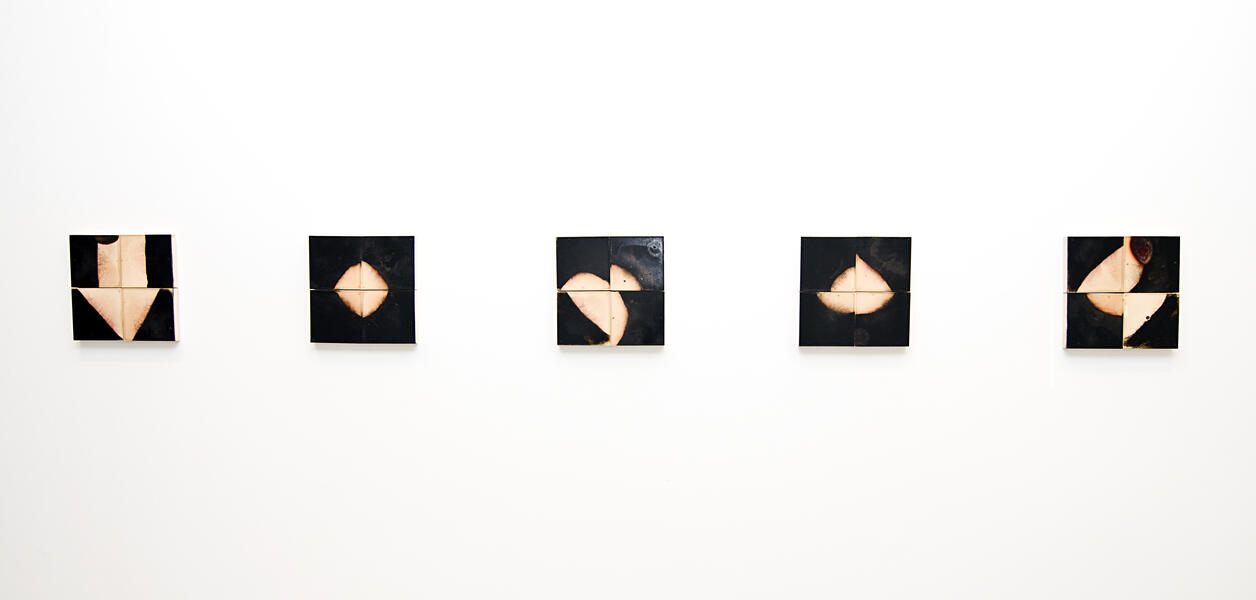 StructuresStructures, Mold on panels, 10x10" each, 2012 at Hamiltonian Gallery, Washington DC.
StructuresStructures, Mold on panels, 10x10" each, 2012 at Hamiltonian Gallery, Washington DC. -
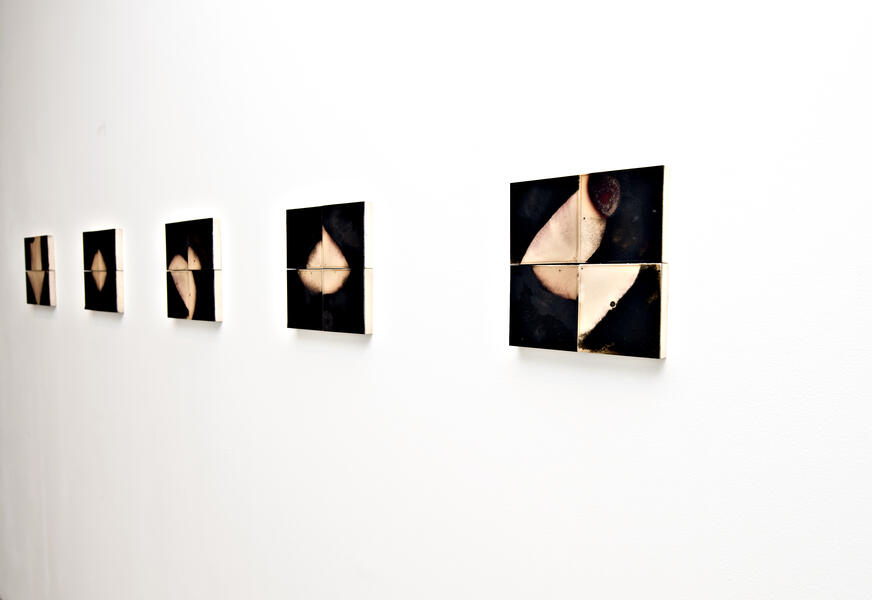 StructuresStructures, Mold on panels, 10x10" each, 2012 at Hamiltonian Gallery, Washington DC.
StructuresStructures, Mold on panels, 10x10" each, 2012 at Hamiltonian Gallery, Washington DC.
Invisible Istanbul
During my residency in Istanbul, I focused on Istanbul’s environmental problems. With a population of 16 million, Istanbul is the largest city in Turkey. Unfortunately, Istanbul has been experiencing environmental pressures due to population growth, industrialization, and rapid urbanization. As a result, Istanbul is experiencing increased air, water, and sea pollution. To address these challenges, I used mold spores as a destructive force. I used landscape images of Istanbul and interrupted the charming scenery with the mold spores isolated from its ground. This project creates a memory of Istanbul; documenting, preserving, and creating a historical record of living beings during my residency period.
-
 Invisible IstanbulInvisible Istanbul, 2021, Microscope slides and mold spores covered with epoxy resin
Invisible IstanbulInvisible Istanbul, 2021, Microscope slides and mold spores covered with epoxy resin -
 Invisible IstanbulInvisible Istanbul, 2021, Microscope slides and mold spores covered with epoxy resin
Invisible IstanbulInvisible Istanbul, 2021, Microscope slides and mold spores covered with epoxy resin -
 Invisible IstanbulInvisible Istanbul, 2021, Microscope slides and mold spores covered with epoxy resin
Invisible IstanbulInvisible Istanbul, 2021, Microscope slides and mold spores covered with epoxy resin -
 Invisible IstanbulInvisible Istanbul, 2021, Microscope slides and mold spores covered with epoxy resin
Invisible IstanbulInvisible Istanbul, 2021, Microscope slides and mold spores covered with epoxy resin -
 Invisible IstanbulInvisible Istanbul, 2021, Microscope slides and mold spores covered with epoxy resin
Invisible IstanbulInvisible Istanbul, 2021, Microscope slides and mold spores covered with epoxy resin
Bordered World
Bordered World creates a competition for resources, territorial wars, and struggle for power and control among living organisms. In this project, I reference the fundamental, underlying social dilemmas and principles of our existence in an effort to understand and highlight social issues. My concepts are explored using living entities such as fungus and mold to recreate observable interactions and conflicts across the picture surface, where the outcomes reveal boundaries, edges and distinctive forms. In Bordered World, all vital resources are restricted. This limited environment makes microbes compete for resources, dominate a particular area or become invasive and endanger others. When they share the same living platform, a conflict for resources arise and eventually this results with a borderline. The behaviors of the microorganisms resemble human actions and motives. Visually representing the world map, these microbes act as metaphors for war and the human predicament.
"In Selin Balci’s bio-art installation Bordered World, 2,500 Petri dishes compose a three-dimensional kaleidoscopic world map representing the universal struggle for survival and dominance. Within each hand “painted” Petri dish, live molds and fungi are in an observable battle for limited resources. Distinctive borders slowly form and new colonies develop during this microscopic feud."
Smack Mellon Curator
-
 Bordered WorldEvolving mold in 2500 Petri dishes at Smack Mellon, Brooklyn, NY, 2014-15
Bordered WorldEvolving mold in 2500 Petri dishes at Smack Mellon, Brooklyn, NY, 2014-15 -
 Bordered WorldEvolving mold in 2500 Petri dishes at Smack Mellon, Brooklyn, NY, 2014-15
Bordered WorldEvolving mold in 2500 Petri dishes at Smack Mellon, Brooklyn, NY, 2014-15 -
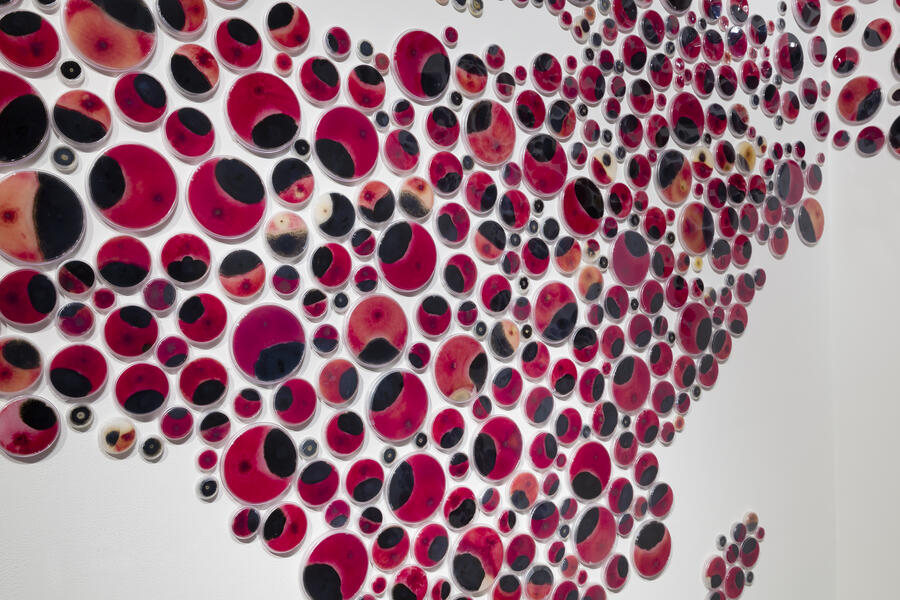 Bordered WorldEvolving mold in 2500 Petri dishes at Smack Mellon, Brooklyn, NY, 2014-15
Bordered WorldEvolving mold in 2500 Petri dishes at Smack Mellon, Brooklyn, NY, 2014-15 -
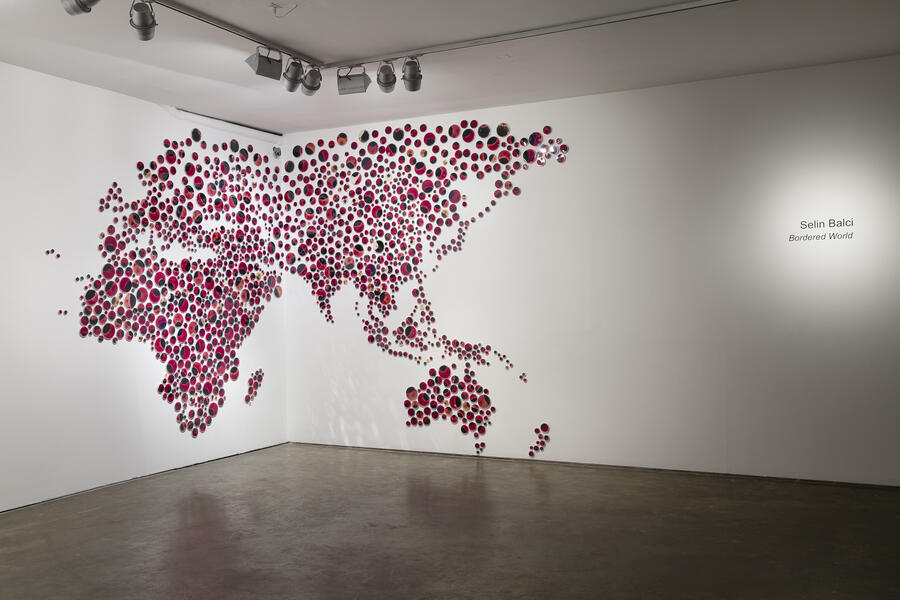 Bordered WorldEvolving mold in 2500 Petri dishes at Smack Mellon, Brooklyn, NY, 2014-15
Bordered WorldEvolving mold in 2500 Petri dishes at Smack Mellon, Brooklyn, NY, 2014-15 -
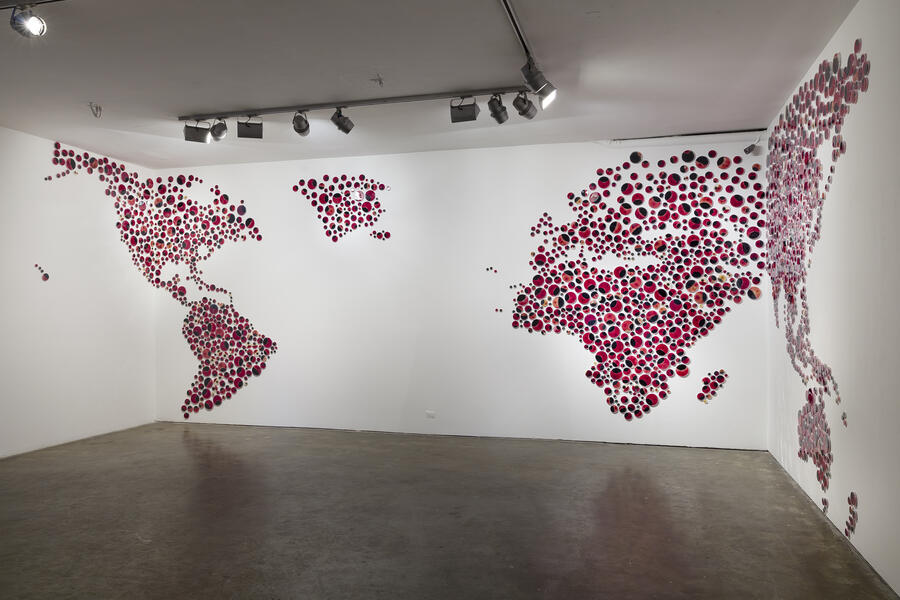 Bordered WorldEvolving mold in 2500 Petri dishes at Smack Mellon, Brooklyn, NY, 2014-15
Bordered WorldEvolving mold in 2500 Petri dishes at Smack Mellon, Brooklyn, NY, 2014-15 -
Installation of Bordered World at Smack Mellon galleryEvolving mold in 2500 Petri dishes at Smack Mellon, Brooklyn, NY, 2014-15
The World
"If the artistic process is more interesting than the outcome, as some modernists hold, then the greatest artist is nature itself. Its systems are endless and inexorable, even if the results aren’t always impressive to the naked eye. Take, for example, the fungal experiments of Selin Balci, one of five former Hamiltonian Artists fellows who return to the gallery in “Empirical Evidence.” The Turkey-born Marylander is exhibiting such seemingly inert items as petri dishes that contain slowly evolving mold spores. Far more dramatic is a more artist-directed piece, a five-minute fast-motion video in which molds spread across a world map. It demonstrates the power and scope of the tiniest living things."
Mark Jenkins, October 1, 2021, The Washington Post
"The map-based works present this phenomenon in stark terms, played out as geopolitical headlines ripped from the paper. The World depicts worlds run amok by war, disease or possibly famine. Faint pencil outlines suggest physical boundaries that the organisms push to the brink. Teaming and frothing, they have no “place” to go, and so they turn on one another in a game of brinkmanship, drawing boundaries with battlegrounds to gain the upper hand. The pieces are both eerie and transfixing, haunting yet mesmerizing, and their underlying message could be ignored offhand, if not because we see similar battles taking place today in regions as remote as Syria and as near as Dallas." Eric Hope for East City Art, 2014.
-
 The WorldThe World (4th version), 2020, Mold spores on panel covered with epoxy resin, 24x40" I used mold to specifically refer to human behavior, culture and society. The world's political map was re-created on a board with growth media (food), then different microorganisms were placed to represent each country. The work demonstrates human actions, form of power, political pressures, immigration, racialism and the dominance of superior countries.
The WorldThe World (4th version), 2020, Mold spores on panel covered with epoxy resin, 24x40" I used mold to specifically refer to human behavior, culture and society. The world's political map was re-created on a board with growth media (food), then different microorganisms were placed to represent each country. The work demonstrates human actions, form of power, political pressures, immigration, racialism and the dominance of superior countries. -
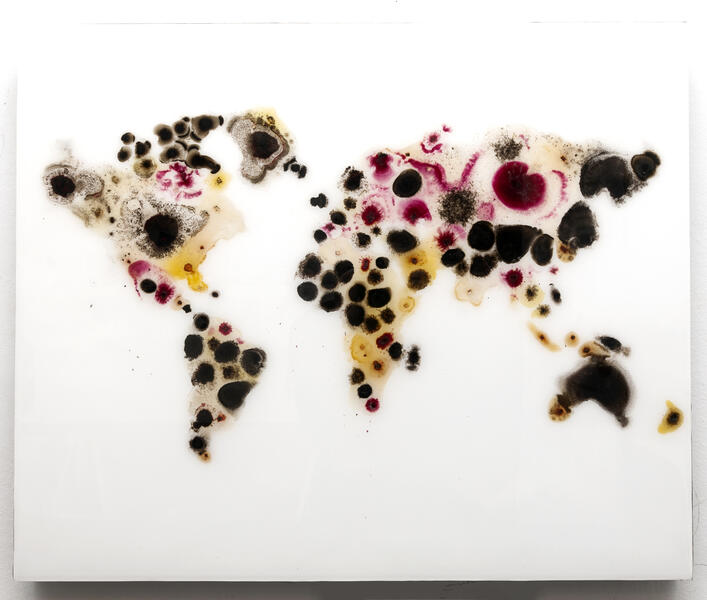 The World (5th version)The World (5th version), 2020, Mold spores on panel covered with epoxy resin, 16x20"
The World (5th version)The World (5th version), 2020, Mold spores on panel covered with epoxy resin, 16x20" -
The WorldThe World, video, originally 4:33min, 2010 I used mold to specifically refer to human behavior, culture, and society. The world's political map was re-created on a board with growth media (food), then different microorganisms were placed to represent each country. The work demonstrates human actions, forms of power, political pressures, immigration, racialism, and the dominance of superior countries.
-
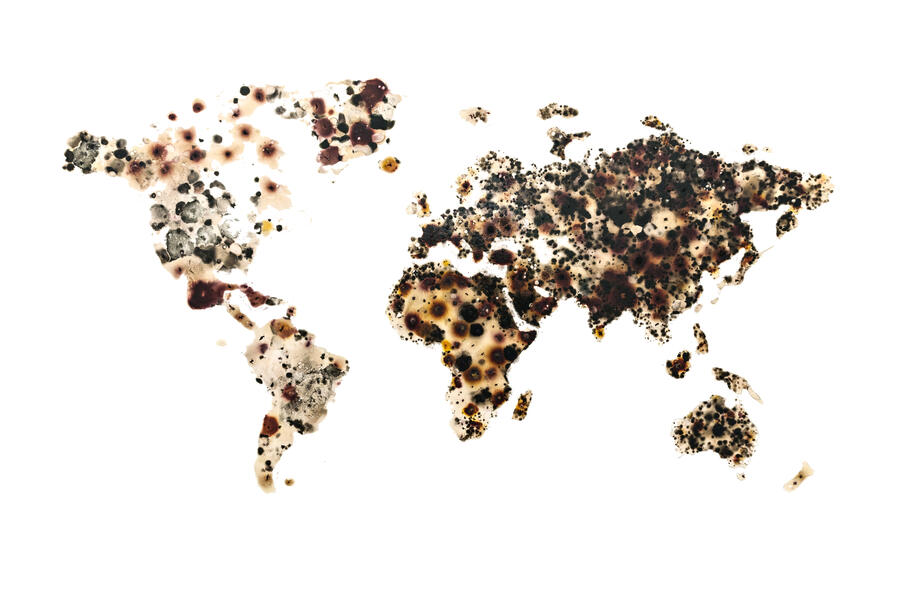 The World (1st version)Mold spores on panel, 2012, 24x40"
The World (1st version)Mold spores on panel, 2012, 24x40"








